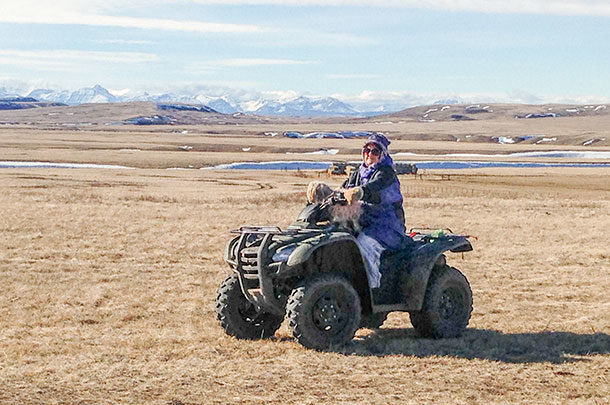Spring and fall are the worst. When you get up, it’s 38 degrees outside, the sun is shining and it’s dead still. The high is supposed to be in the 50s and we are going to be working cattle over at the corrals. How does one dress for this?
First, you must consider method of transportation. If you’ll be riding the four-wheeler to gather cattle, add one layer and your best gloves because your throttle thumb will freeze. Horseback requires slightly fewer layers – jeans, long underwear, chaps, long-sleeved undershirt, sweatshirt, coat – with consideration taken for the height of the horse and the chances you’ll still be able to get on.
Second, here in Glacier County, frost on the morning grass (especially in June) does not mean it won’t be 70 by mid-afternoon, and you must always take into account windchill. Fifty-five degrees with a 7-mile-an-hour breeze will make for a pleasant afternoon. Combine the same temperature with those ugly-looking wind clouds building up behind the mountains – I’m going with the wool ear-flapper hat.
To complicate matters, the climate in our yard has no relationship to the weather at the corrals. Here behind our thick shelterbelt of trees with the morning sun shining warm and bright, one might think it was a balmy day. Step outside the windbreak, though, and it’s another matter entirely. At least once a week I set out, get a quarter mile from the house and turn back for warmer clothes.
The answer, of course, is layers, in every shape and weight. We have severe weather long johns, regular winter long johns and summer long johns (yes, really). Flannel-lined jeans and regular jeans. Lightweight undershirts, wool undershirts and short-sleeved T-shirts. Regular sweatshirts, heavy sweatshirts and fleece-lined sweatshirts, all with a hood that can be cinched over whatever headgear you chose in case the wind gets really nasty. And I’m not even going to start on the coat selection.
In theory, layers should make it simple. Just peel one off or add it back depending on changes in the wind, cloud cover and the cold front that rolls in over the Milk River ridge midday. In practice, when you’re horseback 3 miles from the house, shedding excess coats and gloves can be a bit of a challenge – where do you stow them? Not to mention it’s downright dangerous if you’re riding a colt. Flapping jackets tend to result in a high probability of unintentional dismounting.
And then you start hoofing it around the corral sorting cows and the layers come off in a hurry. Same goes for those rare days when the wind doesn’t come up but the temperature does. You leave the house in the morning fit for an arctic expedition and arrive back for a late lunch in shirtsleeves.
But the biggest challenge is remembering to bring your layers home with you. Otherwise, there will come a morning when there is nary a sweatshirt or a jacket to be found. So if you’ll excuse me, I have to go make the rounds of all the pickups, barns and fence posts to gather up my wardrobe. ![]()
Kari Lynn Dell is a third-generation cowgirl, horse trainer and rodeo competitor. She writes from her family ranch on Montana's Blackfeet Reservation. For information on her novels, short stories and other writing projects, visit her website.
PHOTO: If layering is the key to ranch wear, then rounding up the layers from pickups and fence posts is vital to its survival. Photo by Kari Lynn Dell.











